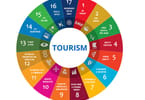WASHINGTON, D.C. – Frequent and even occasional travelers are learning they must factor in add-on airline fees when calculating the full all-in cost of air travel. With the busy holiday travel season approaching, Open Allies for Airfare Transparency asked some travelers how they cope:
For would-be holiday travelers still shopping, remember to factor in:
Baggage fees: Even for those who normally carry-on their luggage, do not overlook the potential cost of baggage fees. Holiday travelers carry more luggage than normal, often carrying gifts and winter coats that fill-up overhead bin space. All travelers should factor in the potential cost of checking a bag and paying the baggage fee. Some carriers also charge baggage fees for carry-ons. Airlines must post those fees on their websites and online travel agencies like Expedia, Orbitz and Travelocity must provide links that list the baggage fees of the airlines that they sell.
Seat assignment fees: During Thanksgiving week, domestic flights averaged 90 percent full and during the upcoming holidays travelers can expect the same. Many airlines have increased the number of “preferred” seats – seats toward the front of the plane, window and aisle seats – that are only available for an additional fee. This can create difficulties for families, particularly those with young children, who need to sit together on flights. To avoid this, be prepared to pay preferred seat fees in order to obtain contiguous seats.
For those who have already booked holiday travel:
Make sure to get seat assignments ahead of time. Selecting seats online and printing boarding passes ahead of time will help avoid long check-in lines and fees for printing boarding passes at the airport. It is likely that guaranteeing seats together on very full holiday flights may require some combination of free and “preferred” seats with extra charges. Airlines typically open up the seat assignment map as the departure date approaches, but by then, there may be even fewer options.
Check baggage fee information, and measure and weigh your bags. The FAA limits all passengers to one carry-on and a personal item such as a purse or backpack. But keep in mind that very full flights may result in even less room for carry-ons. Checked bags that exceed weight limits by even a few pounds may incur even higher fees.
“While savvy consumers are comparison shopping online for the “all-in” cost of their air travel, they are still calling for additional transparency and disclosure,” said David Kelly, Executive Director, Open Allies. “Unfortunately, airlines’ continued refusal to share core fee information — in a simple to use and purchasable format — with online travel sites and travel agents is leading to unnecessary confusion, complexity, and wasted time as consumers track down fee information for each airline. There is simply no reason this fee information shouldn’t be presented all on one screen. That’s why the best gift the Department of Transportation can give to the traveling public is adoption of a new rule requiring the airlines to share fee information in a purchasable format in all the channels through which they sell their airfares.”
WHAT TO TAKE AWAY FROM THIS ARTICLE:
- That’s why the best gift the Department of Transportation can give to the traveling public is adoption of a new rule requiring the airlines to share fee information in a purchasable format in all the channels through which they sell their airfares.
- The FAA limits all passengers to one carry-on and a personal item such as a purse or backpack.
- All travelers should factor in the potential cost of checking a bag and paying the baggage fee.





















